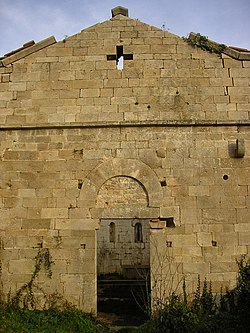Santa Maria di Mirteto Monastery
| Cistercian Abbey of Santa Maria di Mirteto | |
|---|---|
 Remains of the church |
|
| location |
Region Tuscany Province Pisa |
| Coordinates: | 43 ° 45 '3 " N , 10 ° 28' 45" E |
| Serial number according to Janauschek |
596 |
| founding year | 1227 |
| Year of dissolution / annulment |
before 1497 |
| Mother monastery | 1. Fontevivo Monastery 2. San Michele della Verruca Monastery |
| Primary Abbey | Clairvaux Monastery |
|
Daughter monasteries |
no |
Santa Maria di Mirteto Monastery was a Cistercian monk abbey in Tuscany in Italy . It was about 8 km northeast of Pisa in the province of the same name at 295 m above sea level in Monte Pisano above the village of Asciano, 4 km from Bagni di San Giuliano . However, a location between Ninfa and Norma on Monte Mirteto in the province of Latina is also given.
history
It is possible that a smaller predecessor monastery already existed before the Cistercian monastery was founded, which must have taken place around 1227. In a bull by Pope Gregory IX. The Cistercian abbey is mentioned for the first time in 1227. In the statutes of the general chapter of 1257 there is talk of a request for admission to the order. The mother monastery is said to have been the monastery Fontevivo near Parma , with which the monastery would have belonged to the filiation of the Clairvaux primary abbey . In the year 1258, however, there is only talk of a prior, but the abbey is mentioned again in the statutes of the general chapter of 1279. In 1360 the monastery was still occupied by a single monk. It is believed that the facilities of the monastery were insufficient to maintain an independent abbey. Towards the end of the 14th century, the monastery was probably incorporated into the nearby monastery of San Michele della Verruca , which perished before 1497. The church was still used as a private oratory for the Ricci family in 1812. After the settlement was abandoned, the facility fell into disrepair.
Buildings and plant
The monastery still shows its medieval layout. In addition to the church, the remains of the monastery buildings, the granary and the olive press have been preserved. The church is an apse room and contains some sculptures from the High Middle Ages.
literature
- Balduino Gustavo Bedini, Breve prospetto delle Abazie Cistercensi d'Italia , undated (Casamari), 1964, pp. 119–120, without ISBN.